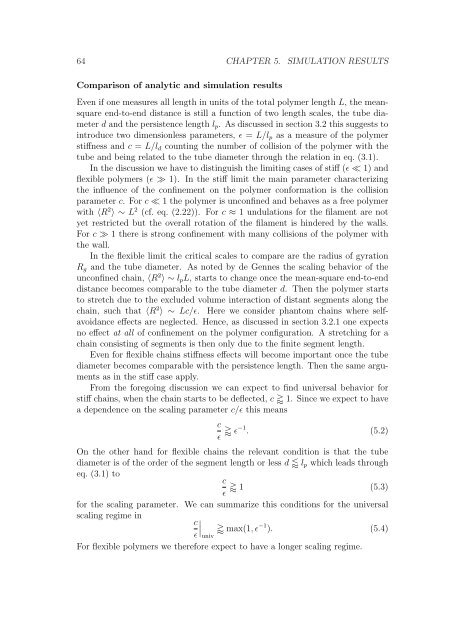Polymers in Confined Geometry.pdf
Polymers in Confined Geometry.pdf
Polymers in Confined Geometry.pdf
You also want an ePaper? Increase the reach of your titles
YUMPU automatically turns print PDFs into web optimized ePapers that Google loves.
64 CHAPTER 5. SIMULATION RESULTS<br />
Comparison of analytic and simulation results<br />
Even if one measures all length <strong>in</strong> units of the total polymer length L, the meansquare<br />
end-to-end distance is still a function of two length scales, the tube diameter<br />
d and the persistence length lp. As discussed <strong>in</strong> section 3.2 this suggests to<br />
<strong>in</strong>troduce two dimensionless parameters, ɛ = L/lp as a measure of the polymer<br />
stiffness and c = L/ld count<strong>in</strong>g the number of collision of the polymer with the<br />
tube and be<strong>in</strong>g related to the tube diameter through the relation <strong>in</strong> eq. (3.1).<br />
In the discussion we have to dist<strong>in</strong>guish the limit<strong>in</strong>g cases of stiff (ɛ ≪ 1) and<br />
flexible polymers (ɛ ≫ 1). In the stiff limit the ma<strong>in</strong> parameter characteriz<strong>in</strong>g<br />
the <strong>in</strong>fluence of the conf<strong>in</strong>ement on the polymer conformation is the collision<br />
parameter c. For c ≪ 1 the polymer is unconf<strong>in</strong>ed and behaves as a free polymer<br />
with 〈R 2 〉 ∼ L 2 (cf. eq. (2.22)). For c ≈ 1 undulations for the filament are not<br />
yet restricted but the overall rotation of the filament is h<strong>in</strong>dered by the walls.<br />
For c ≫ 1 there is strong conf<strong>in</strong>ement with many collisions of the polymer with<br />
the wall.<br />
In the flexible limit the critical scales to compare are the radius of gyration<br />
Rg and the tube diameter. As noted by de Gennes the scal<strong>in</strong>g behavior of the<br />
unconf<strong>in</strong>ed cha<strong>in</strong>, 〈R 2 〉 ∼ lpL, starts to change once the mean-square end-to-end<br />
distance becomes comparable to the tube diameter d. Then the polymer starts<br />
to stretch due to the excluded volume <strong>in</strong>teraction of distant segments along the<br />
cha<strong>in</strong>, such that 〈R 2 〉 ∼ Lc/ɛ. Here we consider phantom cha<strong>in</strong>s where selfavoidance<br />
effects are neglected. Hence, as discussed <strong>in</strong> section 3.2.1 one expects<br />
no effect at all of conf<strong>in</strong>ement on the polymer configuration. A stretch<strong>in</strong>g for a<br />
cha<strong>in</strong> consist<strong>in</strong>g of segments is then only due to the f<strong>in</strong>ite segment length.<br />
Even for flexible cha<strong>in</strong>s stiffness effects will become important once the tube<br />
diameter becomes comparable with the persistence length. Then the same arguments<br />
as <strong>in</strong> the stiff case apply.<br />
From the forego<strong>in</strong>g discussion we can expect to f<strong>in</strong>d universal behavior for<br />
stiff cha<strong>in</strong>s, when the cha<strong>in</strong> starts to be deflected, c 1. S<strong>in</strong>ce we expect to have<br />
a dependence on the scal<strong>in</strong>g parameter c/ɛ this means<br />
c<br />
ɛ ɛ−1 . (5.2)<br />
On the other hand for flexible cha<strong>in</strong>s the relevant condition is that the tube<br />
diameter is of the order of the segment length or less d lp which leads through<br />
eq. (3.1) to<br />
c<br />
1 (5.3)<br />
ɛ<br />
for the scal<strong>in</strong>g parameter. We can summarize this conditions for the universal<br />
scal<strong>in</strong>g regime <strong>in</strong><br />
c<br />
<br />
<br />
max(1, ɛ<br />
ɛ univ<br />
−1 ). (5.4)<br />
For flexible polymers we therefore expect to have a longer scal<strong>in</strong>g regime.













